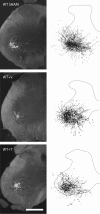Overexpression of androgen receptors in target musculature confers androgen sensitivity to motoneuron dendrites
- PMID: 21147875
- PMCID: PMC3037164
- DOI: 10.1210/en.2010-1197
Overexpression of androgen receptors in target musculature confers androgen sensitivity to motoneuron dendrites
Abstract
The dendritic arbors of spinal motoneurons are dynamically regulated by a variety of factors, and several lines of evidence indicate that trophic interactions with the target musculature are of central importance. In highly androgen-sensitive motoneuron populations, androgens are thought to regulate motoneuron dendrites through their action at the receptor-enriched target musculature. Using rats transgenically modified to overexpress androgen receptor (AR) in skeletal muscle, we directly tested the hypothesis that the enhanced expression of AR in the target musculature can underlie the androgenic regulation of motoneuron dendritic morphology. The morphology of motoneurons innervating the quadriceps muscle was examined in wild-type (WT) rats as well as in rats that had been transgenically modified to overexpress ARs in their skeletal musculature. Motoneurons innervating the vastus lateralis muscle of the quadriceps in gonadally intact male rats, and castrated males with or without androgen replacement, were labeled with cholera toxin-conjugated horseradish peroxidase, and dendritic arbors were reconstructed in three dimensions. In WT rats, quadriceps motoneuron dendrites were insensitive to hormonal manipulation. In contrast, quadriceps motoneuron dendrites in gonadally intact transgenic males were larger than those of WT males. Furthermore, overexpression of ARs in the quadriceps muscle resulted in androgen sensitivity in dendrites, with substantial reductions in dendritic length occurring after castration; this reduction was prevented with testosterone replacement. Thus, it appears that the androgen sensitivity of motoneuron dendrites is conferred indirectly via the enrichment of ARs in the musculature.
Figures






Comment in
-
Muscle matters--dendrites grow up.Endocrinology. 2011 Feb;152(2):346-8. doi: 10.1210/en.2010-1413. Endocrinology. 2011. PMID: 21252180 No abstract available.
Similar articles
-
Neuroprotective effects of testosterone metabolites and dependency on receptor action on the morphology of somatic motoneurons following the death of neighboring motoneurons.Dev Neurobiol. 2017 Jun;77(6):691-707. doi: 10.1002/dneu.22445. Epub 2016 Oct 3. Dev Neurobiol. 2017. PMID: 27569375 Free PMC article.
-
Exercise is neuroprotective on the morphology of somatic motoneurons following the death of neighboring motoneurons via androgen action at the target muscle.Dev Neurobiol. 2021 Jan;81(1):22-35. doi: 10.1002/dneu.22794. Epub 2020 Dec 14. Dev Neurobiol. 2021. PMID: 33289343 Free PMC article.
-
Muscle matters--dendrites grow up.Endocrinology. 2011 Feb;152(2):346-8. doi: 10.1210/en.2010-1413. Endocrinology. 2011. PMID: 21252180 No abstract available.
-
Brain-derived neurotrophic factor and androgen interactions in spinal neuromuscular systems.Neuroscience. 2013 Jun 3;239:103-14. doi: 10.1016/j.neuroscience.2012.10.028. Epub 2012 Oct 24. Neuroscience. 2013. PMID: 23103213 Free PMC article. Review.
-
Androgen receptors and muscle: a key mechanism underlying life history trade-offs.J Comp Physiol A Neuroethol Sens Neural Behav Physiol. 2018 Jan;204(1):51-60. doi: 10.1007/s00359-017-1222-4. Epub 2017 Oct 23. J Comp Physiol A Neuroethol Sens Neural Behav Physiol. 2018. PMID: 29063284 Review.
Cited by
-
The role of androgens and global and tissue-specific androgen receptor expression on body composition, exercise adaptation, and performance.Biol Sex Differ. 2025 Apr 23;16(1):28. doi: 10.1186/s13293-025-00707-6. Biol Sex Differ. 2025. PMID: 40269952 Free PMC article. Review.
-
Transcriptional induction of the heat shock protein B8 mediates the clearance of misfolded proteins responsible for motor neuron diseases.Sci Rep. 2016 Mar 10;6:22827. doi: 10.1038/srep22827. Sci Rep. 2016. PMID: 26961006 Free PMC article.
-
Neuroprotective effects of testosterone on motoneuron and muscle morphology following spinal cord injury.J Comp Neurol. 2012 Aug 15;520(12):2683-96. doi: 10.1002/cne.23066. J Comp Neurol. 2012. PMID: 22314886 Free PMC article.
-
Neuroprotective effects of testosterone metabolites and dependency on receptor action on the morphology of somatic motoneurons following the death of neighboring motoneurons.Dev Neurobiol. 2017 Jun;77(6):691-707. doi: 10.1002/dneu.22445. Epub 2016 Oct 3. Dev Neurobiol. 2017. PMID: 27569375 Free PMC article.
-
Autophagic and Proteasomal Mediated Removal of Mutant Androgen Receptor in Muscle Models of Spinal and Bulbar Muscular Atrophy.Front Endocrinol (Lausanne). 2019 Aug 20;10:569. doi: 10.3389/fendo.2019.00569. eCollection 2019. Front Endocrinol (Lausanne). 2019. PMID: 31481932 Free PMC article.
References
-
- Ulfhake B, Cullheim S. 1988. Postnatal development of cat hind limb motoneurons: II. In vivo morphology of dendritic growth cones and the maturation of dendrite morphology. J Comp Neurol 278:88–102 - PubMed
-
- Burke RE. 1990. Spinal cord: ventral horn. In: Sheperd GM. ed. The synaptic organization of the brain. New York: Oxford University Press; 88–132
-
- Ulfhake B, Kellerth JO. 1981. A quantitative light microscopic study of the dendrites of cat spinal a-motoneurons after intracellular staining with horseradish peroxidase. J Comp Neurol 202:571–583 - PubMed
-
- Chen XY, Wolpaw JR. 1994. Triceps surae motoneuron morphology in the rat: a quantitative light microscopic study. J Comp Neurol 343:143–157 - PubMed
-
- Mainen ZF, Sejnowski TJ. 1996. Influence of dendritic structure on firing pattern in model neocortical neurons. Nature 382:363–366 - PubMed
Publication types
MeSH terms
Substances
Grants and funding
LinkOut - more resources
Full Text Sources
Research Materials

